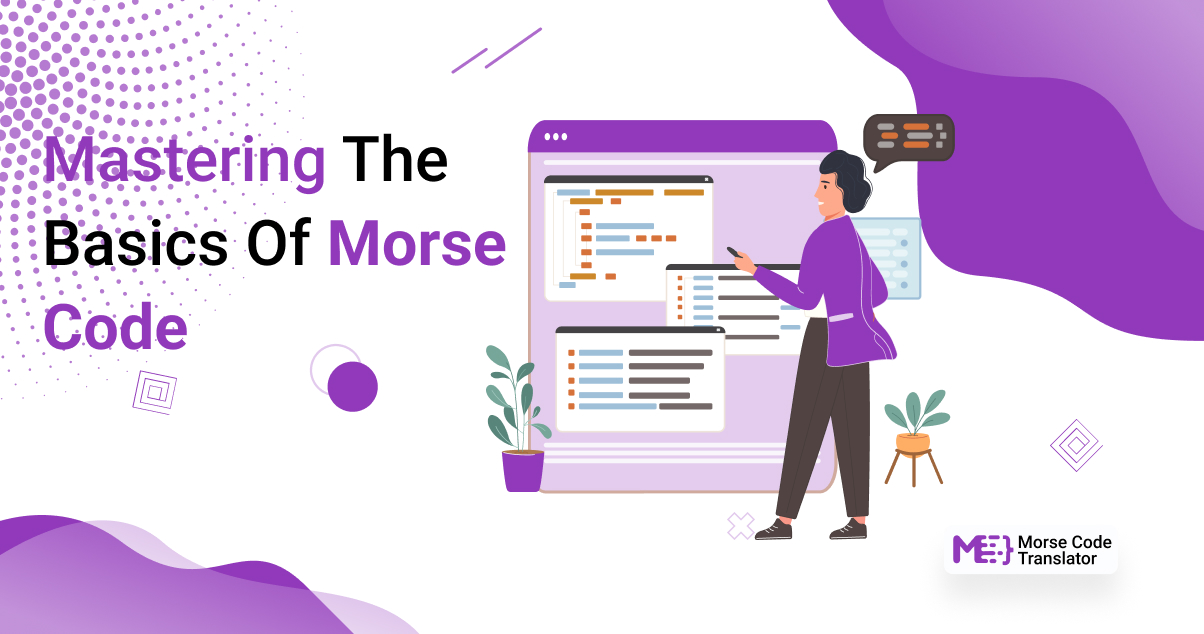Mastering the Basics of Morse Code
 Steve Wilson
Steve Wilson

Introduction
Morse code is a system of communication that uses a series of dots and dashes to represent letters and numbers. Developed by Samuel Morse in the 1830s, it was primarily used for telegraph communication. It was an important method of long-distance communication before the invention of the telephone and the internet. Despite its decline in popularity in recent years, it is still an important skill to have, particularly for amateur radio operators and emergency services personnel. It is also used in aviation and maritime communication as a backup method of communication. In this article, we will take a look at the basics of Morse code.
Brief history of Morse code
The history of Morse code dates back to the 1830s when Samuel Morse, an American inventor and artist, along with Alfred Vail, developed a system of communication using a series of dots and dashes to represent letters and numbers. This system was first demonstrated in 1838, and soon after, Morse code was adopted as the standard for telegraph communication in the United States.
The first telegraph message transmitted using Morse code was sent on May 24, 1844, from Washington, D.C. to Baltimore, Maryland, This marked the beginning of a new era of long-distance communication, making it possible to transmit messages across the country in a matter of minutes, rather than days or weeks. Morse code became the primary method of long-distance communication before the invention of the telephone and the internet.
Importance of learning Morse code
Learning Morse code is an important skill to have, even in today's world where technology has advanced significantly. For one, it is still used in some fields, particularly in amateur radio, where it is a requirement for obtaining a license. It is also used in emergency services as a backup method of communication. In case of power outages, natural disasters or other emergency situations, communication infrastructure may be down, and knowing Morse code can be a lifesaver. Additionally, it is used in aviation and maritime communication as a backup method of communication.
Furthermore, learning Morse code can also be a fun and rewarding hobby. It can help improve memory, concentration and typing skills. It is a simple and efficient method of communication that can be used in a variety of situations, it is easy to learn and with a little bit of practice, anyone can master it.
Overall, learning Morse code is not only a useful skill to have in certain professional fields, but it is also a fun and rewarding hobby that can improve cognitive abilities.
How to Read and Write in Morse Code
To read and write in Morse code, one must first understand the basic code. Each letter and number is represented by a unique combination of dots and dashes. For example, the letter "A" is represented by a single dot followed by a single dash, while the letter "Z" is represented by two dashes followed by two dots. The number "1" is represented by a single dot, and "0" is represented by a single dash.
Once you have learned the basic code, it is important to practice reading and writing in Morse code. There are various resources available such as online quizzes and flashcards that can help with memorization. It's also beneficial to practice listening to Morse code transmissions, as well as sending messages in Morse code.
When reading Morse code, it is important to listen for the rhythm of the code, as well as the spacing between letters and words. It's also helpful to focus on the sounds of the individual dots and dashes, rather than trying to mentally translate them into letters and numbers.
When writing in Morse code, it is important to practice sending messages at a steady pace, and to use proper spacing between letters and words. With a little bit of practice and patience, anyone can learn to read and write in Morse code.
Translation of letters and numbers
The translation of letters and numbers in Morse code is relatively simple. Each letter and number is represented by a unique combination of dots and dashes. The letters A-Z are represented as follows:
B -... O --- 1 .----
C -.-. P .--. 2 ..---
D -.. Q --.- 3 ...--
E . R .-. 4 ....-
F ..-. S ... 5 .....
G --. T - 6 -....
H .... U ..- 7 --...
I .. V ...- 8 ---..
J .--- W .-- 9 ----.
K -.- X -..-
L .-.. Y -.--
M -- Z --..
With a little bit of practice and patience, anyone can master the translation of letters and numbers in Morse code.
Tips for memorizing the code
Memorizing the code of Morse code can be challenging, but there are several tips that can help make it easier:
Start with the most frequently used letters and numbers. These are the ones that you will use most often, so it's important to have them memorized first.
Practice regularly. The more you practice, the easier it will become to remember the code. Set aside a specific time each day to practice, and make it a regular habit.
Use flashcards or other visual aids. These can help you to associate the code with the letters and numbers they represent.
Use mnemonic devices. These can help you to remember the code by linking it to something that is easy to remember, like a word or phrase.
Practice listening to and sending messages in Morse code. This will help you to become more familiar with the rhythm and spacing of the code.
By following these tips and practicing regularly, you will be able to memorize the code of Morse code in no time.
Resources for practicing
There are many resources available to help with practicing and mastering Morse code. Some of the most popular include:
Online quizzes and flashcards: These are a great way to test your knowledge and memorization of the code. There are many websites that offer quizzes and flashcards specifically designed for learning Morse code.
Practice software and apps: There are a variety of apps available for both mobile and desktop devices that can help with practicing and learning Morse code. Some apps also include interactive lessons and quizzes to test your knowledge.
Amateur radio clubs and organizations: Many amateur radio clubs and organizations offer classes and training in Morse code. Joining one of these groups can provide you with access to experienced operators who can offer guidance and support.
Books and other printed materials: There are many books and other printed materials available that provide detailed information about Morse code, including its history, use, and techniques for mastering it.
YouTube videos and Podcasts: There are plenty of YouTube videos and Podcasts available that can help with learning and practicing Morse code, many of them are made by experts and hobbyists, they can be a great resource for learning and practicing.
With the variety of resources available, it's easy to find one that works best for you and start practicing.
Conclusion
Learning Morse code can be challenging, but with the right resources and practice, anyone can master it. It is an essential skill for amateur radio operators and emergency services personnel, as well as an interesting hobby for anyone interested in communication technology.
It is a reminder of the ingenuity and resourcefulness of early communication pioneers, and it serves as a window into the past. It is a unique way of communicating that is still relevant today and will continue to be so.